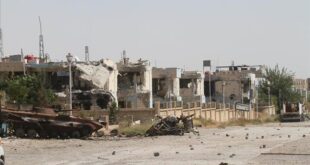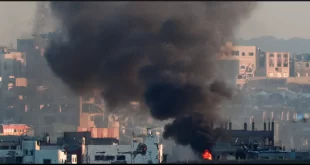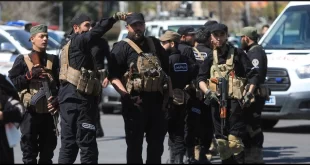by Steven Sahiounie, published on Mideast Discourse, September 9, 2024
The ancient bazaar in Aleppo, Syria has been restored and is open for business once more. The long alleyway of shops was severely damaged after the US-sponsored mercenaries of the Free Syrian Army (FSA), and their Al Qaeda allies, fought savage battles against the Syrian Arab Army (SAA) beginning in the summer of 2012.
Aleppo is the industrial capital of Syria, and business is in the DNA of the residents. The UN recognizes Aleppo and Damascus as the oldest continuously inhabited cities on earth.
When the Jewish, Christian, and Muslim prophet Abraham traveled through Aleppo on his way west, he stopped to milk his cow, and the city became named Haleb, a form of the Arabic word for milk. The locals call their town Haleb still today, even though Abraham made his journey some 9,000 years ago. Aleppo is the western form of the name Haleb.
Many sections of the bazaar, also referred to as the ‘souk’, and other medieval structures in the ancient city were destroyed, ruined, or burnt due to fighting in 2012.
Al-Madina Souk is the covered bazaar in the heart of Aleppo within the walled medieval section of the city, and a UNESCO World Heritage Site since 1986. Considered to be the longest-covered historical market on earth, it stretches about 13 kilometers. Imported silk from Iran, spices from India, and Chinese goods all arrived on the camels of the Silk Road caravans. The iconic olive oil soap is one of the staple items sold there.
The restored row of shops, encompassing four souks, stretches for about 100 meters (330 feet) across the Old City. Three other souks of a total of 37 have been restored in previous years, with the funds coming from both public and private sources.
The FSA and Al Qaeda destroyed the bazaar, even though it had no military value or connection to the Syrian government in Damascus. They destroyed it to break the soul of the city. Its destruction successfully tore apart the social fabric, and the city of industry was brought to its knees by the US-NATO attack on Syria for regime change.
Aleppo merchants began to formulate their options as to how they could survive the war which raged until December 2016, when the SAA defeated the FSA and Jibhat al-Nusra.
The terrorist remnants were bused to Idlib under a surrender deal, and are there and holding the residents under occupation. Ongoing street protests in Idlib have demanded the fall of the terrorist leader, Muhammed al-Julani, formerly of Al Qaeda, Jibhat al-Nusra, and ISIS, but calling his group today Hayat Tahrir al-Sham.
Many Aleppo merchants, some with long unbroken ancestral ties to Aleppo spanning thousands of years, migrated to Turkey and Egypt where they opened restaurants, shops, and factories. Some have since returned to Aleppo as conditions for Syrians abroad became difficult.
If it took 9,000 years to make Aleppo, it took just a few years of armed conflict to destroy parts of the city. The eastern residential section was devastated after the FSA, and the Al Qaeda branch in Syria, Jibhat al-Nusra, embedded themselves among the poor eastern neighborhoods, which did not resist the invaders because they had no weapons to fight back.
Wedad Muhammed, a resident of eastern Aleppo, told me they all went to sleep one night, and the next day they woke up under the occupation of armed fighters. The FSA, despite its complete support by the administration of US President Obama and VP Joe Biden, insisted on Radical Islamic ideology to be obeyed by the residents. Women had to wear chin-to-floor black cloaks and black head scarves and were not allowed to work in shops where the clientele might be men. Wedad recalled being stopped in the street by the FSA. They accused her of adding decorations to her cloak. She innocently explained the cloak was ready-made and she had not added any embellishment to it. The decoration in question was some sequins stitched to the cuffs. Men who smoked cigarettes in public were beaten, and if you voiced criticism of the FSA or their allied terrorists, you faced being put in prison.
One of the complaints currently in Idlib is over the imprisonment, torture, and killing of those opposed to the rule of al-Julani and his terrorists.
The western sections of Aleppo tried to live life but were daily bombarded by rockets fired indiscriminately from the fighters in eastern Aleppo. The fighters seeking to overthrow the government, to create an Islamic State in Syria, were not targeting SAA positions exclusively. They were targeting Syrian civilians, and this is why the armed opposition was hated in Syria because their war targeted the people, not the government.
The armed wing of the Syrian Opposition was not a grass-roots band of freedom fighters. They lost the war, and the Damascus government survived billions of dollars being spent to overthrow them. The Obama war on Syria proved unsuccessful, and no American goals were achieved, despite the US taxpayer throwing billions of their hard-earned income at the project which has cost hundreds of thousands of lives and created the largest refugee crisis in modern history.
Western media, especially CNN, sold a narrative to the American people, who were paying for the FSA and their allies to destroy Syria. The mainstream media propaganda portrayed the fighters in Syria as local Syrians fighting for freedom and democracy, values that every American holds dear. But, according to locals who lived through the war in Aleppo, many of the fighters were international terrorists, with no ancestral ties to Syria. For example, when L.Z. (name withheld for safety) saw the red-bearded terrorists from Chechnya in her neighborhood before her home was destroyed, causing her family to flee to the western section of Aleppo. Many of the terrorists had been transported to Aleppo through Turkey and were landed at Istanbul airport, then bused by Turkish security forces to the border north of Aleppo.
One Armenian woman fled to Kessab after losing her home in Aleppo, only to be driven out of Kessab in March 2014 by the same FSA and their Al Qaeda allies as they attacked, destroyed, and occupied Kessab on the Turkish border for three months.
Aleppo and its people are slowly recovering, but with the US sanctions in place, and a Syrian economy at a low point, it may be decades before the country can rebuild and refurbish all that was lost in a matter of seconds when missiles and bombs landed.
Steven Sahiounie is a two-time recipient of the Serena Shim Award for Uncompromised Integrity in Journalism
 Syria Support Movement solidarity with the Syrian people
Syria Support Movement solidarity with the Syrian people




